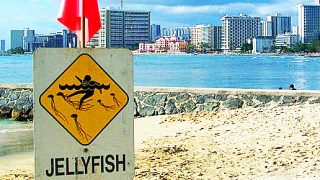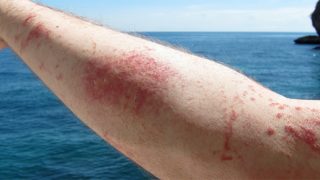If you think that the exchange rate from Dollars to Euros isn’t enough to spoil your European beach vacation, and send you packing to Hawaii, there is a new and potentially serious problem arising there.
The Economist is reporting an unprecedented invasion of jellyfish on European beaches this summer. Theorists point to global warming, overfishing and ocean pollution as likely causes.
Jellyfish, marine invertebrates, contain a powerful venom used to instantly stun or kill prey, like fish and shrimp. The toxins affect the skin and the nervous system. A jellyfish sting can cause residual pain for weeks.
Hawaiian Box Jellyfish. There is no reported increase. These are found mostly on south facing Hawaii beaches, about 9- 10 days following the full moon each month. They are a nuisance, but we

Box jellyfish are typically pale blue and transparent. Their name comes from their box-like bodies, and their tentacles can reach up to 10 feet.
What to do. First be sure to check the Hawaii jellyfish schedule . Then if you see jellyfish on the beach or in the water, use caution.
If you are stung by a jellyfish, you should:
- Apply vinegar to the area.
- Remove any visible tentacles with tweezers or by brushing them off using a towel or anything other than your hands.
- Try using cold or hot packs to reduce pain.
- Get medical help if you have a severe reaction. For some people, as with bee stings, there is a danger of anaphylactic shock.
For more information, check out this jellyfish sting Q&A.
Get Breaking Hawaii Travel News




